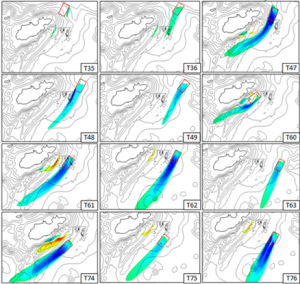The effect of tidal stream turbine arrays upon sediment dynamics has received little attention to date due to, on one hand, lack of installed arrays and on the other lack of high resolution bathymetric survey data.
However, we are now at the stage where there are some serious plans for implementing arrays of size tens to hundreds of turbines. One of the areas of sea where such plans exist is the Race of Alderney (49.7 degrees N, 2.1 degrees W), where an extensive but highly dynamic sandbank lies a few hundred metres from the main tidal race.
There are a number of real-world sites suitable for exploitation where tidal sand banks are found adjacent to regions of maximum tidal streams. These may be particularly sensitive to flow acceleration effects due to the large proportion of sand in motion on the bank during a tidal cycle and the strongly non-linear nature of sediment transport. In the case of the Alderney South Banks, the local body responsible for regulating renewable energy developments (Alderney Renewable Energy Commission, ACRE) wants to ensure that long term changes to the sandbank are not likely to result from tidal power development. Therefore site-specific numerical modelling of hydrodynamic and sedimentary processes has been carried out to assess the possible long-term impacts of a number of different tidal turbine array configurations.
The challenges in carrying out this task are formidable as the tidal flows are complex in this region and modelling of tidal turbine arrays is subject to uncertainty in parameterization in a domain of this scale. Not to mention the uncertainties involved in sediment transport modelling itself. Nevertheless, using high resolution bathymetry and ADCP datasets provided by ACRE, in combination with a validated regional tidal model, has made it possible to produce a hydrodynamic model with tidal ellipse error parameters generally less than 10% at validation locations. This has given a robust baseline for the comparative assessment of a set of hypothetical tidal turbine arrays.
